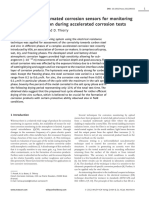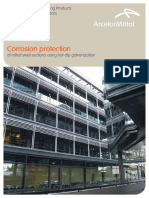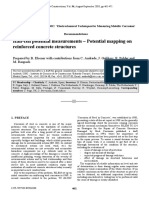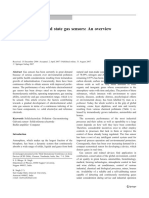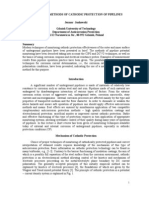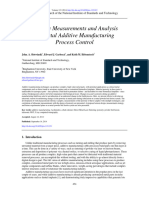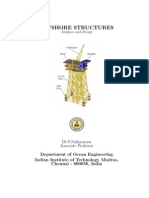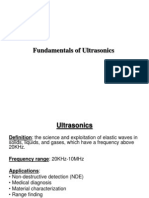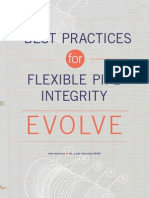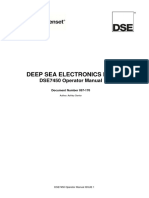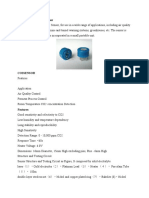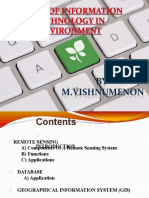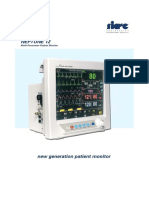AirCorr Paper
AirCorr Paper
Uploaded by
naren57Copyright:
Available Formats
AirCorr Paper
AirCorr Paper
Uploaded by
naren57Original Description:
Copyright
Available Formats
Share this document
Did you find this document useful?
Is this content inappropriate?
Copyright:
Available Formats
AirCorr Paper
AirCorr Paper
Uploaded by
naren57Copyright:
Available Formats
Page 1
Real-time monitoring of indoor air corrosivity in cultural heritage institutions
with metallic electrical resistance sensors
T. Prosek
1
, M. Kouril
2
, M. Dubus
3
, M. Taube
4
, V. Hubert
5
, B. Scheffel
6
, Y. Degres
7
, M. Jouannic
7
,
D. Thierry
1
1
Institut de la Corrosion / French Corrosion Institute, Brest, France
2
Institute of Chemical Technology, Dept. of Metals and Corrosion Engineering, Prague, Czech Republic
3
Centre de Recherche et de Restauration des Muses de France, Paris, France
4
The National Museum of Denmark, Dept. of Conservation, Brede, Denmark
5
Swiss National Museum, Collection Centre, Affoltern am Albis, Switzerland
6
Fraunhofer Institute for Electron Beam and Plasma Technology, Dresden, Germany
7
nke, Hennebont, France
Abstract
A system for continuous monitoring of atmospheric corrosivity has been developed. An electronic unit
measures and records changes in the electrical resistance of a thin metal track applied on an insulating
substrate. If the metal corrodes, the effective cross-sectional area of the track decreases and the electrical
resistance increases. Sensors made of silver, copper, iron/steel, zinc, lead, tin, aluminium, bronze and brass at
thicknesses from 50 nm to 250 m were tailored for environments with different corrosivities. The developed
technology proved capable of providing high sensitivity, allowing for real-time corrosion monitoring even in
low-corrosive indoor cultural heritage facilities. Laboratory tests showed good reproducibility with the
standard deviation of parallel measurements at less than 20% for metals which corrode uniformly in the
tested environments. Several examples selected from a broad testing programme in partner museums,
libraries and other institutions show successful applications of the logger system for characterisation of air
quality control in indoor locations, during transport and in temporary exhibitions; assessment of new
buildings and storage facilities; and fundamental studies of optimal conservation and storage procedures. A
first outline of a classification system for lead, which is particularly sensitive to the presence of carboxylic
acids, is given. The technique has a large potential as an independent method for monitoring air quality in
facilities displaying and storing valuable objects of cultural heritage.
Keywords: Air quality control; Metal corrosion; Material degradation; Reactive monitoring; Copper; Silver
Introduction [heading]
A great number of both movable and stationary cultural assets are managed by cultural heritage authorities
all over the world. Degradation of culturally-significant objects stored or displayed in indoor premises is
Page 2
affected by air temperature, relative humidity, concentration of pollutants such as sulphur dioxide, nitrogen
oxides, ozone, ammonia, hydrochloric acid, sulphates, dispersed chlorides, organic acids, other volatile
compounds and dust particles. Although the deterioration of objects due to the presence of indoor pollutants
is often slow, its cumulative effect is largely surpassing much more spectacular damages caused by fires,
theft, earthquakes, flooding etc. combined.
Due to a high number of possible indoor pollutants and their interactions and costs and technical problems
associated with monitoring them, it is only the relative humidity and temperature that are controlled and
monitored by most institutions. Air filters, scavengers and other additional anti-corrosion measures are
applied only to protect most valuable collections or when valuable and often-irreplaceable historical objects
have already been affected. Any air quality control scheme without application of a monitoring technique
giving rapid feedback on the air quality might be either inadequate or excessive, and thus too costly. Thus,
information on the actual corrosivity of the atmosphere is crucial to the effective corrosion protection.
Direct impact of atmospheres on objects is traditionally followed by exposing coupons of given materials to
the environment and consequent analysis of their degradation after given period of time. For non-metallic
materials, the coupon technique is rarely used, but projects on development of specific coupons or
dosimeters are in progress [1]. In contrary, it is well established for metallic materials. According to current
standards, a metal coupon needs to be exposed for 30 days or for 1 year in given environment. The impact of
the environment on metal degradation is evaluated in a specialized laboratory based on mass loss, mass gain
or coulometric reduction of corrosion products. The mass loss procedure is used for an assessment of outdoor
corrosivity whereas the mass gain is measured usually on coupons exposed indoors. The coulometric
reduction of corrosion products is more demanding with respect to equipment and experience, but can
provide an indication of the nature of the pollution in addition to the rate of metal degradation.
However, none of the coupon techniques can be considered as real-time. Within the exposure period,
valuable objects might further deteriorate if the air is contaminated. Thus, there is a strong need for a tool
enabling cultural heritage professionals to assess the air corrosivity in real time. Because open-air museums,
artefacts of industrial activities, and even entire factories are presently recognized as important parts of
cultural heritage, the need for atmospheric corrosion monitoring is not limited to indoor conditions with air
quality control but must also be available for outdoor environments.
Whereas there is a relatively wide range of products for corrosion monitoring in aqueous media, the
availability of means for real-time corrosion monitoring in the atmosphere is limited. Thus, an electronic
logger enabling a continuous measurement of the corrosion rate of selected metals in air has been developed.
The electrical resistance (ER) technique was selected to measure the corrosion rate within projects supported
by the European Commission [2,3]. The technique is described in, e.g., ASTM standard G96 [4]. The
principle of the method is that the electrical resistance of a measuring element made of the material of
interest increases as its effective cross-sectional area decreases due to corrosion. In practice, two such
elements are built into a probe. One element is exposed to the corrosive environment and corrodes, whereas
Page 3
the other element is shielded and, thus, protected from corrosion. The resistances of both elements are
measured at the same time and resistivity changes due to varying temperature are compensated for. Based on
the initial cross-sectional area of the exposed element, the cumulative metal loss at the time of reading can be
determined. The benefits of the ER technique include its versatile nature as it can be used in practically any
kind of environment, robustness and ability to provide continuous measurements [5,6].
This paper provides a description of the technique, results of laboratory tests on its reproducibility,
sensitivity and accuracy and several examples of applications in cultural heritage institutions.
Corrosion monitoring system [heading]
The monitoring system is comprised of four principal parts: an electronic logger for measuring and recording
ER, a metal sensor that actually corrodes in the environment, a communication interface between the logger
and computer and a software programme for interpretation of the measurement.
The concept of the measuring device is simple and yet highly effective: the electronic unit measures and
registers the change over time of the electrical resistance of a thin metal track applied on an insulating
substrate. A schematic drawing of the sensor is shown in Figure 1. The width of the measuring track is from
1 to 2 mm, depending on sensor type, and the length is over 100 mm. This geometry ensures high sensitivity
to changes in the electrical resistance due to metal corrosion.
In contrast to traditional designs [7], the sensing and reference parts of AirCorr sensors are connected by an
H-shaped bridge. The edge of the protective coating passes approximately through the middle of the bridge.
Thus, the edge of the protective coating is neither part of the sensing nor of the reference track and the bridge
serves only as a conductor for passage of the testing current. The measuring part of the track is placed a safe
distance from the coating edge. This design solves a common problem of ER probes, which is corrosion of
the metallic track at the interface between the sensing and reference parts underneath the protective coating,
which can lead to erroneous readings [10]. A patent application has been filed to protect this unique solution.
The sensitivity and service life of the sensors depend on the thickness of the metallic track: the lower the
thickness, the higher the sensitivity. On the other hand, low thickness leads to a shorter service life. The
service life can be assessed as the time to consume one half of the track thickness. Therefore, sensors with
different track thicknesses are available for applications in different environments.
Assuming that the electrical conductivity of the track is proportional to the remaining metal track thickness and
assuming that corrosion products do not contribute to the conductivity, the corrosion depth of the metallic
sensor, h, can be calculated according to equation
|
|
.
|
\
|
= A
sens
ref
init sens
init ref
init ref
R
R
R
R
h h
,
,
,
(1)
Page 4
where h
ref,init
is the initial thickness of the reference metallic track, which is considered to be equal to the
sensing track at the beginning of exposure, R
sens
and R
ref
are the resistances of the sensor and reference tracks
at the time of measurement, and R
sens,init
and R
ref,init
are the initial resistances of the sensor and reference
tracks [810]. The calculation is based on the electrical resistances measured as a potential difference along
the track through which defined currents pass. The equation has been improved compared to the earlier one
in order to be valid throughout the whole service life of the sensor [5].
For indoor use, the protection of the reference track against corrosion is provided by an organic adhesive
tape coated with an inorganic diffusion barrier layer. The coating is transparent to avoid differential heating
of the tracks.
Sensor materials and thicknesses are listed in Table 1. Photographs of several types of thin- and thick-film
sensors are shown in Figure 2.
The changes in electrical resistance are recorded by precise electronic loggers. Three versions of AirCorr
loggers were developed for specific applications as seen in Figure 3. The basic versions of the electronic
logger, I and O, are encased within a small watertight polycarbonate box measuring 1006537 mm with a
tightness of IP 65. For the indoor version, I, the logger lid is provided with a connector so the sensor can be
easily replaced when necessary. Version O for outdoor applications in highly corrosive environments has an
attached sensor protected with a robust polyurethane casting. The lid can be replaced when the sensor is at
the end of its useful life. The devices are equipped with an LED that signals when the unit is on. Version I
Plus is also designed for indoor use and can measure the air corrosivity on two sensors of identical or
different metals. In addition, temperature and relative humidity are registered. Current corrosivity and
climatic parameters can be read on a build-in LCD display. The cadence of the measurement can be adjusted
from minutes, to hours, to even days if necessary in order to match the sensitivity of the measurement with
the anticipated corrosion rate.
Collected and stored data can be downloaded by a non-contact inductive data reader, even through showcase
glass. A GPRS/GSM access unit is optional and allows remote data access and control with automatic data
delivery via e-mail. The loggers are designed to be autonomous for five years. The battery itself is also
replaceable. The loggers are fully independent of any power supply, any external control, and can, therefore,
be placed anywhere. User-friendly software allowing for rapid interpretation of results and incorporating
existing and proposed standards and recommendations has been developed. Further information is available
elsewhere [11].
Laboratory testing [heading]
Sensitivity of measurement [sub-heading]
The sensitivity of the thin film sensors developed for lightly-polluted indoor locations was tested in air
during a cycle comprising changes in relative humidity from 30 to 85% and changes in temperature from 20
Page 5
to 30 C. An example of such measurement is given for a copper sensor with the metal track thickness of
500 nm in Figure 4. The sensor was initially exposed to air at ambient temperature and a low relative
humidity of about 33%. It was then transferred to a climatic chamber with controlled temperature and
relative humidity of 20 C and 85 %. Finally, the temperature was increased to 30 C. As seen in Figure 4a,
the changes in the air corrosivity were observable within several minutes. Figure 4b shows extrapolated
curves indicating that the corrosion rate of copper increased from 0.3 nm/month (3 nm/year) in dry air to
2 nm/month (24 nm/year) in humid air at 20 C and further to 7 nm/month (85 nm/year) at the elevated
temperature of 30 C. The rates correspond to corrosivity classifications of IC 1 Very low, IC 2 Low and
IC 3 Medium, respectively, according to ISO 11844-1 [12]. The standard requires 1-year exposure in a
given environment to establish the classification and the obtained data are thus only indicative. Anyway, the
experiment demonstrates the extreme sensitivity of the technique and the ability to assess the air corrosivity
within only several hours.
The corrosion depth h can be recalculated to corrosion build-up b (thickness of the layer of corrosion
products) using equation
CP
M
h c
b
A
= (2)
where
M
is density of metal (8.9 g cm
3
for copper), c is a ratio between the mass of formed corrosion
products and the mass of corroded metal (1.5 for copper [12]) and
CP
is density of the corrosion products
(6.0 g cm
3
for cuprous oxide, Cu
2
O [13]). Details on the formula construction and its limitations are given
elsewhere [14]. The corrosivity can be classified based on the corrosion build-up under all conditions as G1-
level Mild using ANSI/ISA-71.04-1985 [15]. According to the corrosivity classification of indoor
atmospheres developed by Sacchi and Muller in particular for museums and archives, the two former
environments can be classified as S1, Extremely pure and the last one as S2, Pure [16].
A logger with Ag-50nm sensor was exposed to a climatic chamber with air maintained at constant
temperature of 25 C and cycling relative humidity. It started at 80% RH, then dropped to 40% and increased
again to 60% and 80% RH. Two such cycles were carried out each day. Records of RH and corrosion depth
are plotted in Figure 5. At 40% RH, the corrosion rate was negligible. Corrosion rates of about 50 and 130
nm/year were recorded at 60% and 80% RH, which corresponds to IC 2 Low and IC 3 Medium
classifications by ISO 11844-1 [12]. The Sacchi and Muller classification system marks the respective
environments as S2, Pure and S3, Clean [16]. The recording shows good reproducibility of the sensor
response in multiple cycles.
The sensitivity of the measuring device with regard to corrosion may be defined as the minimum mass of
corroded metal required for a reliable response of the ER measurement. For a metal film with constant
thickness, the extent of corrosion can be represented as a corrosion depth assuming a homogeneous decrease
of metal thickness. Such calculated corrosion depth is a mean value based on simplified model assumptions.
Seemingly very small changes in corrosion depth values at sub-ngstrm (<10
10
m) level can be calculated
Page 6
using equation (1), but these do not have a direct physical meaning. Such changes can instead be associated
with oxidation of a portion of an atomic layer. Localised corrosion, e.g. at grain boundaries, would obviously
strongly influence the ER of a thin metallic track. Nevertheless, the simple model has proven to be
successful.
This sensitivity was at least 1/1000 of the initial metal track thickness varying from below 0.1 nm (<10
10
m,
<1 ) for sensors developed for low-corrosive indoor environments to 200 nm for the robust 250-m steel
sensor designed for highly corrosive outdoor applications. The sub-ngstrm sensitivity of the thin-film
sensors is very apparent in the recordings shown in Figure 4a and in Figure 5.
Reproducibility and accuracy of measurement [sub-heading]
A series of experiments were performed in air with controlled temperature, relative humidity and
concentrations of carboxylic acids. Formic acid and acetic acid were released to feed air at concentrations
from several tens to close to 3000 ppb. The experiments were partly reported previously [10,8,9] and a paper
with further results has been submitted for publication [17]. In each experiment, three parallel loggers with
identical sensors were exposed to assess the measurement reproducibility. The measured corrosion depths
with standard deviations are shown in Figure 6. With exception of the Fe-800nm sensors in air with formic
acid, the reproducibility was better than 20%. The large scatter for parallel Fe-800nm sensors was due to
non-uniform corrosion.
Because of the high sensitivity of the setup, it was not possible to compare the results to those obtained using
traditional techniques following measurements in low-corrosive atmospheres. To get an idea of the accuracy
of the technique, thick-film sensors for outdoor applications were tested in two accelerated tests. The ECC1
test according to Renault standard D17 2028/2002 is a cyclic wet/dry test performed at a constant
temperature of 35 C and comprises spraying the samples with a solution of 1 wt. % NaCl at pH 4 for 30
minutes each day. The second test, which follows the EN ISO 3231 standard is run at 40 C and at 100 %
RH in air with 500 ml of SO
2
generated in a 300-litre chamber. Selected sensors were exposed to the tests
together with corresponding metal coupons. At the end of the exposure, the weight loss of the coupons was
evaluated following ISO 8407. The weight loss results were re-calculated to corrosion depths assuming that
the corrosion was uniform. As seen in Figure 7, the reproducibility was even higher than for the thin-film
sensors and good correlation between the corrosion depths measured by the electrical resistance sensors and
the metal coupons was obtained in most cases. The Cu-9m sensors gave significantly higher corrosion
depths than the coupons and an improved sensor with a higher thickness, Cu-12m, had to be developed as a
replacement.
The data usually show somewhat higher corrosion depth for the ER sensors than for metal coupons. This is
not surprising since the ER technique gives by its nature the maximal depth of attack, while the coupon
technique provides an average corrosion depth. For example, the Zn-50m sensor exposed to the SO
2
test
showed 2-times higher corrosion depth than the coupons and cross-section examination revealed that it was
Page 7
due to non-uniformity of the corrosion. In principle, the applicability of the electrical resistance technique is
thus limited to conditions where the corrosion of a given material proceeds mostly uniformly. In a lower
extent, the readings for the sensors can be also affected by the edge effect, which is practically negligible in
the case of metal panels.
Testing in real environments [heading]
Introduction [sub-heading]
In 2011 and 2012, a large end-user testing programme was conducted in order to assess the performance of
the AirCorr monitoring system in real environments and to obtain feedback for the last stage of development.
Over 25 loggers with multiple sensors were distributed to conservators and other cultural heritage
professionals around the world. The following partners participated in the testing programme: Swiss
National Museum (Schweizerisches Nationalmuseum); Centre for Research and Restoration of the Museums
of France (Centre de Recherche et de Restauration des Muses de France); National Museum of Denmark
(Nationalmuseet); English Heritage, UK; Swiss National Library (Schweizerische Nationalbibliothek NB);
Museum of Art History (Kunsthistorisches Museum), Austria; Australian War Memorial; St. Fagans:
National History Museum, Wales, UK; The Royal Library (Det Kongelige Bibliotek), Denmark; Czech
National Archive (Nrodn archiv), Czech Republic and The Mariners' Museum, USA. The loggers were
used to assess old and new storage facilities, to study the effects of supposedly corrosive factors on air
corrosivity, in comparative studies of showcases, for ranking of locations and institutions, for problem
solving and in fundamental studies on optimal conservation techniques. Several examples of the applications
are given below.
Loan of tapestry [sub-heading]
A unique historical tapestry with copper threads from collection of the Louvre Museum was loaned to two
galleries in Japan. A logger equipped with a Cu-500nm sensor accompanied it on its journey to monitor the
air quality surrounding the tapestry. The recording plotted in Figure 8 reveals that although the relative
humidity and temperature were kept close to target levels, the air corrosivity varied with time. Packing,
transport to Japan in a crate, exhibition in Gallery 1 and transport to Gallery 2 were associated with only
minor corrosion with the cumulative corrosion depth in 3 months reaching 1.8 nm. However, upon opening
the transport box and exhibiting the tapestry in Gallery 2, the corrosivity increased significantly. During the
3-month exhibition in Gallery 2, 8.5 nm of copper corroded and the corrosion rate in the first month was
7.6 nm/30 days. Although this still corresponds to IC 2 Low corrosivity class according to ISO 11844-1
[12], the air quality control was not ideal in Gallery 2. The record shows that aside from higher fluctuation in
the relative humidity, a small amount of some pollutant had to be present in the air to accelerate the
corrosion rate of copper. In particular, the increase in the corrosion depth starting on 30/06 indicates
deterioration of the air quality.
Page 8
Such information is indeed very valuable for future decisions on loans and the conservation measures
required from partner institutions.
Assessment of a new archive building [sub-heading]
The corrosion aggressiveness of the atmosphere within a multi-story building made of reinforced concrete
which was to be used as an archive for paper documents was determined using silver and copper sensors.
The buildings concrete was poured during winter. The upper floors were completed at below-freezing
temperatures, so an antifreeze agent containing urea was added to the concrete. Urea decomposes slowly in
concrete releasing ammonia to the surrounding environment. Indeed, the air in the top floors has a typical
ammonia odour. It is believed that ammonia in the air is not harmful to the documents but might be
dangerous for the metallic parts of stored objects made of copper or brass. A stable temperature of 15 C and
relative humidity of 52 % is maintained in the archive.
An AirCorr I Plus logger equipped with two highly sensitive sensors, silver 50nm and copper 50nm, was
installed in the archive. Initially, the logger was placed on a floor built from urea-free concrete with no
ammonia odour. Then, it was moved to a floor with a strong ammonia odour. The aim was to test the effect
of ammonia-type air pollutants on the air corrosivity. During the exposure in the odour-free area, the
measured corrosion depth of 2.1 nm corresponds to the corrosion rate of 27 nm/year for the silver sensor, see
Figure 9. The testing period was not long enough to classify the corrosivity according to the ISO 11844-1
standard but extrapolation of the data yields the IC 2 Low corrosivity class. The corrosion rate identified at
the same location for copper was 5 nm/year (h of 0.4 nm) corresponding to the IC 1 Very low
classification. After moving the logger onto the floor with the ammonia odour, the corrosion rate of silver
dropped to 16 nm/year and remained constant during whole exposure period. In the case of copper, the
corrosion rate was 2 nm/year and it slowly decreased.
Surprisingly, the corrosivity on the floor with the ammonia odour was lower than in non-polluted areas. The
surface of copper was analysed by XPS after the exposure. The film of corrosion products contained a
significant amount (app. 50 %) of copper (II) and nitrogen bound up in an organic compound. Since urea is
known for its corrosion inhibition toward copper, adsorption of urea from the atmosphere onto the metallic
surface might be the reason for the reduction in the corrosion rates of copper and silver during exposure on
the upper floor. The study showed that the locations made with the urea-modified concrete were safe for
documents with copper and bronze parts, at least in the short term. The effect of this specific environment on
other types of stored materials and its long-term effect on copper and copper-alloy materials is under study.
A quartz crystal microbalance logger was exposed alongside the AirCorr I Plus logger. It recorded a mass
gain of the copper- and silver-coated crystals. The corrosion build-up after 38 days was 1.6 nm and 0.9 nm
for the silver and copper sensors, respectively [18]. When the AirCorr data on corrosion depth are
recalculated to corrosion build-up using Eq. (2), the results are 3.5 and 0.8 nm, respectively. For silver, the
following values were used for the calculation:
M
= 10.5 g cm
, c = 1.15 [12] and
CP
(Ag
2
S) = 7.3 g cm
Page 9
[13]. Silver sulphide is dominating on metal objects exposed to indoor atmospheres [16] and was assumed
to represent density of the entire layer of corrosion products. Although the build-up on silver differs by a
factor of 2, identical corrosivity classification was provided and the measurements are in a reasonably good
agreement.
Regular air quality monitoring of indoor premises [sub-heading]
The Danish Royal Library considered AirCorr loggers as a possible replacement for passive sampling, which
is carried out regularly at different locations within the institution. The high cost and delay of at least
2 months between the samplers deployment and return of the results are considered drawbacks of the
passive sampling method.
An Ag-50nm silver sensor was used. The monitoring was carried out at three locations over a total of
5 months. It started in a small room containing manuscripts with low air exchange, Location 1. Passive
sampling showed elevated concentrations of acetic and formic acids. The logger was then moved to storage
with air filtration and climate control, Location 2. Acetic acid was not detected and the concentration of
formic acid was very low in the second location. Finally, the monitoring was carried out in a visitor centre
with low levels of organic acids but non-negligible outdoor pollution in form of SO
2
, NO
2
and O
3
, Location
3. Cumulative data for the silver sensor along with the results of the accompanying passive samplers and the
relative humidity record are shown in Figure 10. The corrosion depth of silver measured in the first 30 days
at each of the locations reached 2.0, 0.2 and 4.8 nm, respectively. The air quality classifications according to
the ISO 11844-1 standard were IC 2 Low, IC 1 Very low and IC 2 Low [12]. Following the Sacchi and
Muller recommendation, S1, Extremely pure class would apply to the first two premises and S2, Pure to the
last one [16].
Location 2 with tight air quality control was one order of magnitude less corrosive than Location 1 with
elevated levels of organic acids. The highest corrosivity was found in the visitor centre (Location 3), which
was open to outdoor air containing typical urban pollutants, including sulphur dioxide, nitrogen dioxide and
ozone. Although silver is not particularly sensitive to these compounds, the last two have some effect on its
corrosion stability.
Study on the optimal cleaning procedure of brass inlays [sub-heading]
Restorers at the Louvre Museum were searching for the optimal cleaning procedure for the engraved brass
inlays in a valuable wooden cabinet attributed to Andr-Charles Boulle that had been selected for an
important exhibition. The engravings, made from alpha-phase brass containing 35 wt.% zinc, had been
partially damaged by previous cleanings. About 0.5 mm (500 nm) of the initial inlays thickness had already
been removed and the restorers had to be sure that any technique used for the cleaning would be as gentle as
possible. Studies were carried out using the AirCorr system to measure reduction in metal thickness. Because
brass sensors are only available at a thickness of 10 m, which is not extremely sensitive, a bronze CuSn8-
Page 10
400nm sensor was used for the initial measurements. Four cleaning procedures were applied and changes in
the corrosion depth of the sensor were monitored. In addition, roughness measurements and microscopic
evaluation were carried out to assess the outcome of each cleaning technique.
The data obtained are plotted in Figure 11. Several of the treatments resulted in good results with limited
material loss, including the application of an animal glue with triammonium citrate (TAC), which is also
used to restore the marquetry and which resulted in a nice surface appearance; ivory black, a very gentle
abrasive; and micromesh 1200, a corundum-based abrasive. The corrosion depths caused by these cleaning
procedures was in the range of 9 to 17 nm. On the other hand, the procedure using triethanol amine (TEA)
and Pemulen gel led to material removal corresponding to 181 nm and thus cannot be considered a gentle
technique. Roubo lacquer is a Sandarac-based resin dissolved in alcohol, which is named after a French
cabinetmaker who wrote "The Art of the Carpenter" in 1769. It was applied and then removed without
causing any metal corrosion.
Since the composition of the applied sensor was different from the brass of the inlays, the tests will be
repeated with CuZn37-10m sensors. Although the composition and microstructure is not (and cannot) be
identical to that of the historical material and the material loss due to cleaning would probably be somewhat
different, it is believed that the obtained data allow for a comparison of the various cleaning procedures.
Systematic classification of air quality using copper sensors [sub-heading]
Corrosion monitoring by two types of ER loggers, including AirCorr, was used to assess the air quality in
numerous predominantly indoor cultural heritage locations with the aim of responding to questions
frequently asked by conservators and curators on the appropriateness of the conservation conditions in a
given museum, showcase or storage. Changes in corrosion depth of Cu-500nm copper sensors were followed
in the course of a year either by intermittent measurements or by continuous monitoring. Results of studies
performed in twenty museums, libraries and archives situated in France are presented elsewhere [14]. Most
of the locations were heated (twenty-six showcases, eleven exhibition rooms, fifteen storages, six crates), but
in sixteen sites the climate was not controlled, including two outdoor exposures.
The data obtained on the corrosion depths of the copper sensors were interpreted using the ISO 11844-1
standard [12]. 60 % of the environments had very low corrosivities (IC 1) and 5 % were highly corrosive
(IC 5). The corrosivity was found to be low for two-thirds of the heated rooms and high for 3%. In half of the
permanent exhibitions, the corrosivity was found to be very low (IC 1); it was low (IC 2) or medium (IC 3)
for the rest.
The ER technique showed to be a very efficient tool for assessing the conditions of conservation in archives,
libraries and museums. It allowed for comparison of the conditions of conservation in particular locations
and for assessment of any applied countermeasures. A drawback of the currently available standard is the
necessity that the probe be exposed for a full year in a given environment. Due to the high sensitivity of the
ER measurement, reproducible results can be obtained in a shorter period. The ISO 11844-1 classification
Page 11
was thus compared to the Sacchi & Muller guideline based on 30-day exposures [16]. In most cases, good
correlation to ISO 11844-1 was obtained.
Classification of air quality with lead sensors [sub-heading]
The air quality in low-corrosive environments can be qualified by the reactivity of copper [15], copper and
silver [16] or copper, silver, carbon steel and zinc [12]. Parallel exposures of more than one metal are carried
out due to the different sensitivities of different metals to the presence of specific pollutants. For example,
carbon steel is particularly sensitive to chloride, silver to hydrogen sulphide and copper to sulphur
dioxide [19]. However, none of these metals is very sensitive to the carboxylic acids that are repeatedly
reported as important pollutants in enclosed locations in indoor cultural heritage institutions such showcases
and cabinets. Concentrations of formic and acetic acids released from hemicellulose-containing wrapping
papers and cardboards; exhibited or stored objects made of wood, paper and some plastics; and conservation
and showcase materials can vary from negligible to hundreds or even thousands of ppb [2027]. The acids
are harmful to metals, calcareous materials and possibly also paper and some plastics. Lead is particularly
sensitive to the presence of vapours of carboxylic acids.
Because of accelerated corrosion in air polluted with formic and acetic acid and the number of lead objects in
museums, it is of interest to use lead as an additional sensing material. Unfortunately, no current standard
includes lead. Little is also known about the kinetics of lead corrosion in such environments due to the low
sensitivity of currently available techniques. The Pb-400nm and Pb-25m sensors developed for the AirCorr
loggers provide a unique opportunity to acquire valuable knowledge on lead corrosion and establish an air
corrosivity classification system for this metal. The lead sensors were exposed at 15 locations within the end-
user testing programme for 30 days or longer. Some of the locations were reportedly corrosive towards lead
objects and others were supposed to be benign. The corrosion depths registered within first 30 days of
exposure varied from 0.1 to 107 nm. Examples of two consecutive measurements in the Australian War
Memorial in a showcase where the lead pieces of a ship model corroded are given in Figure 12. Corrosion
rates of 90 and 104 nm/30 days were recorded. Although the work is still in the beginning stages and much
more corrosion and supporting data need to be obtained to establish a classification system for lead, a
preliminary proposal dividing atmospheres into four classes based on the corrosion depth of lead after
30 days of exposure is outlined in Table 2. It is possible that one more class will be needed to cover
extremely polluted and corrosive environments.
It is interesting to note that any classification based on exposure of copper and silver is irrelevant for lead
objects. Several of the experiments conducted with lead were accompanied by parallel exposure of silver
and/or copper sensors. Even in conditions where the corrosion rate of lead reached over 10 nm/30 days, i.e.
Class L 3 according to the proposal in Table 2, IC 1 Very low or IC 2 Low classes were obtained for
silver and copper.
Page 12
High-corrosive environment in a paper mill [sub-heading]
Besides the cultural heritage sphere, the monitoring system was tested in selected highly demanding
environments in order to prove its robustness. As an example, the results from an application in a sludge
press building of a pulp and paper manufacturing facility located in Southern USA are shown in Figure 13.
The principal corrosive factors are a high concentration of 100130 ppb of H
2
S, high humidity and
deposition of chemically-active aerosol. During the first seven days of exposure, 340 nm of a Cu-500nm and
143 nm of a Ag-500nm sensor corroded, corresponding (after linear extrapolation) to corrosion rates of
19 and 8 m/year and corrosion build-ups of 3400 and 1100 nm/30 days, respectively. Such corrosivity is
outside the scale of the ISO 11844-1 standard and in the most corrosive class according to other standards
and recommendations.
The curve in Figure 13 shows the high reactivity of the sensor. The actual corrosion rate corresponded to
changes in RH. When the RH crossed 80 %, the corrosion rate increased significantly. The corrosion rate
was the lowest in a period where the RH was about 5060 % (0.3 nm/hour). It increased above 1.5 nm/hour
when the RH was over 80 % and it reached a maximum of 3.7 nm/hour when the RH exceeded 90 %.
Conclusions [heading]
The developed technology proved to provide extreme sensitivity at a sub-ngstrm (<10
10
m), i.e. atomic,
level allowing for real-time corrosion monitoring even in low-corrosive indoor cultural heritage premises.
Due to short response times, immediate countermeasures can be applied in case of an increase in the
atmospheric corrosivity.
It was shown that the technique is reproducible with the standard deviation for parallel measurements at
20 % or lower for metals corroding mostly uniformly in a given environment. Since the response
corresponds to the maximal cross-section reduction and is thus close to the maximal depth of corrosion
attack, the resulting corrosion depth is usually somewhat higher than that found by methods measuring the
average corrosion depth.
A widespread testing programme was conducted in partner museums, archives, libraries and other
institutions to demonstrate the potential of the real-time reactivity monitoring by the ER technique. AirCorr
loggers were successfully applied for the characterisation of air quality control in indoor locations, during
transport and in temporary exhibitions; assessment of new buildings and storage facilities; and fundamental
studies of optimal conservation and storage procedures. Unique sensors made of lead and some alloy
materials can provide useful insight into corrosion of these materials that was difficult or even impossible to
acquire earlier. A first outline of a classification system for lead, which is particularly sensitive to presence
of carboxylic acids, is proposed.
It is believed that the technique has a large potential as an independent method for monitoring air quality in
facilities displaying and storing valuable objects of cultural heritage.
Page 13
Acknowledgments
We gratefully acknowledge financial support by the European Commission under the Seventh Framework
Programme, contract number 226539. All members of the project team are thanked for their contributions.
We wish to especially thank to the museum professionals who agreed to participate in the end-user testing
programme. Barbara Reeve and George Bailey of The Australian War Memorial, Frdric Leblanc, Marc
Aucouturier, Marc-Andr Paulin of Centre de Recherche et de Restauration des Muses de France, Birgit
Vinther Hansen of The Royal Library of Denmark, Jim Huza of Full Circle Protection and Richard N.
Cowles of International Paper are thanked for kind agreement to use the data obtained in their studies.
References
1. Measurement, Effect Assessment and Mitigation of Pollutant Impact on Movable Cultural Assets;
Innovative Research for Market Transfer (MEMORI), 7
th
Framework Programme of the European
Commission, Grant Agreement No. 265132, 11/201010/2013.
2. Automated corrosion sensors as on-line real time process control tools (CORRLOG), Co-operative
Research Project, 6
th
Framework Programme of the European Commission, Grant Agreement No.
018207, 09/200502/2008.
3. Protection of cultural heritage by real-time corrosion monitoring (MUSECORR), Collaborative
Project, 7
th
Framework Programme of the European Commission, Grant Agreement No. 226539,
06/200907/2012.
4. ASTM G96, Standard Guide for On-Line Monitoring of Corrosion in Plant Equipment (Electrical
and Electrochemical Methods), West Conshohocken, USA: ASTM International.
5. Prosek, T., Kouril, M., Hilbert, L.R., Degres, Y., Blazek, V., Thierry, D., & Hansen, M. . 2008.
Real time corrosion monitoring in the atmosphere using automated battery-driven corrosion loggers.
Corrosion Engineering, Science and Technology, 43 (2): 129133.
6. Prosek, T., Thierry, D., Kouril, M., & Degres, Y. 2008. Automated corrosion loggers for corrosion
monitoring in the atmosphere. In: Proceedings of CORROSION, NACE, Paper 08296, New Orleans,
USA, March 1620.
7. Sjgren, L., & Le Bozec N. 2004. On-line corrosion monitoring of indoor atmospheres. In:
Proceedings of Eurocorr, Nice, September 1216.
8. Prosek, T., Kouril, M., Dubois, F., Scheffel, B., Dubus, M., Degres, Y., Hubert, V., Taube, M., &
Thierry, D. 2011. Corrosion monitoring in model indoor atmospheres polluted with organic acids
using automated real time corrosion sensors. In: Proceedings of the European Workshop on Cultural
Heritage Preservation, EWCHP, Berlin, Germany, September 2628. Fraunhofer IRB Verlag.
Page 14
9. Prosek, T., Dubois, F., Kouril, M., Scheffel, B., Degres, Y., Jouannic, M., Taube, M., Dubus, M.,
Hubert, V., & Thierry, D. 2011. Application of automated corrosion sensors for real-time monitoring
in atmospheres polluted with organic acids. In: Proceedings of 18
th
International Corrosion
Congress, Paper 436, Perth, Australia, ISSN 1442-0139, November 2024.
10. Kouril, M., Prosek, T., Scheffel, B., & Dubois, F. (n.d.) High-sensitivity electrical resistance sensors
for indoor corrosion monitoring. Corrosion Science, Engineering and Technology. Sent for
publication.
11. www.musecorr.eu [accessed 30 September 2012].
12. ISO 11844-1. 2006. Corrosion of metals and alloys classification of low corrosivity of indoor
atmospheres Part 1: determination and estimation of indoor corrosivity, International Organization
of Standardization, Genve, Suisse.
13. Campbell, W. E., & Thomas, U. B. 1939. Tarnish studies. The Electrolytic Reduction Method for the
Analysis of Films on Metal Surfaces. Transaction of the Electrochemical Society, 76: 303328.
14. Dubus, M. , Degres, Y., & Prosek, T. (n.d.) Standardized assessment of cultural heritage
environment by electrical resistance measurement. e-Preservation Science. Sent for publication.
15. ANSI/ISA-71.04-1985, Environmental conditions for process measurement and control systems:
Airborne contaminants, ANSI/ISA-The Instrumentation, System and Automation Society, 1986.
16. Sacchi, E., & Muller, C. 2005. Air quality monitoring at historic sites: Redefining an environmental
classification system for gaseous pollution. ASHRAEE Journal, 47(8): 40.
17. Prosek, T., Dubois, F., Kouril, M., & Thierry, D. (n.d.) Effect of carboxylic acids on corrosion of
copper, bronze and iron in model indoor atmospheres using automated electrical resistance sensors.
Corrosion Science. Sent for publication.
18. Kouril, M., Prosek, T., Scheffel, B., & Degres, Y. (n.d.) Corrosion monitoring in archives by the
electrical resistance technique. Journal of Cultural Heritage. Sent for publication.
19. Leygraf, C., Graedel, T. 2000. Atmospheric corrosion. New York: Wiley Interscience.
20. Brimblecombe, P. 1990. The composition of museum atmospheres. Atmospheric Environment, 24B:
18.
21. Gibson, L.T., Cooksey, B.G., Littlejohn, D., & Tennent, N.H. 1997. A diffusion tube sampler for the
determination of acetic acid and formic acid vapours in museum cabinets. Analytica Chimica Acta,
341: 1119.
22. Ryhl-Svendsen, M., & Glastrup, J. 2002. Acetic acid and formic acid concentrations in the museum
environment measured by SPME-GC/MS. Atmospheric Environment, 36: 39093916.
Page 15
23. Godoi, A.F.L., Van Vaeck, L., & Van Grieken, R. 2005. Use of solid-phase microextraction for the
detection of acetic acid by ion-trap gas chromatographymass spectrometry and application to
indoor levels in museums. Journal of Chromatography A, 1067: 331.
24. Schieweck, A., Lohrengel, B., Siwinski, N., Genning, C., & Salthammer, T. 2005. Organic and
inorganic pollutants in storage rooms of the Lower Saxony State Museum Hanover, Germany.
Atmospheric Environment, 39: 60986108.
25. Loupa, G., Charpantidou, E., Karageorgos, E., & Rapsomanikis, S. 2007. The chemistry of gaseous
acids in medieval churches in Cyprus. Atmospheric Environment, 41: 90189029.
26. Chiavari, C., Martini, C., Prandstraller, D., Niklasson, A., Johansson, L.-G., Svensson, J.-E., slund,
A., & Bergsten, C. J. 2008. Atmospheric corrosion of historical organ pipes: The influence of
environment and materials. Corrosion Science, 50: 24442455.
27. Gibson, L.T., & Watt, C.M. 2010. Acetic and formic acids emitted from wood samples and their
effect on selected materials in museum environments. Corrosion Science, 52: 172178.
Page 16
Figures
Pb-400nm Cu-50nm CuSn8-400nm Fe-250m
Figure 2 Photographs of selected corrosion sensors
Version I:
Indoor version with
an exchangeable
sensor
Version I Plus: Indoor version
with temperature and RH sensors,
2 exchangeable corrosion sensors, LCD
showing current corrosivity
Version O:
Watertight
outdoor
version
Figure 3 Three versions of corrosion loggers
Figure 1 Schematic drawing of corrosion sensor
Page 17
Figure 4 Corrosion depth measurement in air using a Cu-500nm sensor (a) and extrapolated stabilised parts of
the corrosion depth curve (b)
0
1
2
3
4
5
6
7
1 10 100 1000 10000
C
o
r
r
o
s
i
o
n
d
e
p
t
h
,
h
[
n
m
]
Time [minutes]
21C
33% RH
20C
85% RH
30C
85% RH
7 nm/30 days
2 nm/30 days
0.3 nm/30 days
Figure 5 Record of corrosion depth of Ag-50nm sensor during humidity cycling in air at 25 C
a
b
Page 18
Figure 6 Corrosion depth measurements for different sensors in air at 20 C containing acetic acid (AA) and
formic acid (FA) with error bars showing the standard deviation; exposure conditions differed for each
sensor type
Figure 7 Comparison of corrosion depth measured using AirCorr sensors and metal coupons in a cyclic
accelerated test comprising sample spraying with NaCl (ECC1) and in air containing SO
2
(SO2); exposure
duration differed for each sensor type
1.1
4.3
2.1
3.4
148.3
32.0
0
1
2
3
4
5
AA FA AA, FA FA FA FA
CuSn-500nm CuSn-500nm Ag-50nm Cu-500nm Fe-800nm Pb-800nm
C
u
m
u
l
a
t
e
d
c
o
r
r
o
s
i
o
n
d
e
p
t
h
,
h
[
n
m
]
/100 /10
Page 19
Figure 8 Corrosion depth, temperature and relative humidity during transport and exhibition of a tapestry
loaned by Louvre museum
Figure 9 Record of silver and copper corrosion depth in an archive building
0
1
2
3
4
0 10 20 30 40 50 60
C
o
r
r
o
s
i
o
n
d
e
p
t
h
,
h
[
n
m
]
Time [days]
Urea-free area
Ag-50nm
27 nm/year
IC 2
Area treated with urea
Cu-50nm
16 nm/year
IC 1
5 nm/year
IC 1
2 nm/year
IC 1
Page 20
Figure 10 Corrosion depth recorded on Ag-50nm sensor at three locations in The Danish Royal Library;
ND: Not detected
Figure 11 Cleaning of a CuSn8-400nm sensor using different techniques
0
20
40
60
0
3
6
9
12
0 30 60 90 120
R
e
l
a
t
i
v
e
h
u
m
i
d
i
t
y
,
R
H
[
%
]
C
o
r
r
o
s
i
o
n
d
e
p
t
h
,
h
[
n
m
]
Time [days]
Location 1
Acetic acid: 108 g/m
Formic acid: 125 g/m
SO
2
: 0.3 g/m
NO
2
: 2 g/m
O
3
: ND
2.0 nm/30 days
Location 2
Acetic acid: ND
Formic acid: 2 g/m
SO
2
: ND
NO
2
: ND
O
3
: ND
0.2 nm/30 days
4.8 nm/30 days
Location 3
Acetic acid: 36 g/m
Formic acid: 22 g/m
SO
2
: 1 g/m
NO
2
: 19 g/m
O
3
: 26 g/m
h
RH
0
50
100
150
200
0 5 10 15 20
C
o
r
r
o
s
i
o
n
d
e
p
t
h
,
h
[
n
m
]
Time [days]
C
l
e
a
n
i
n
g
w
i
t
h
a
n
i
m
a
l
g
l
u
e
+
T
A
C
11 nm
181 nm
17 nm
9 nm
7 nm
C
l
e
a
n
i
n
g
w
i
t
h
T
E
A
/
P
e
m
u
l
e
n
g
e
l
C
l
e
a
n
i
n
g
w
i
t
h
i
v
o
r
y
b
l
a
c
k
C
l
e
a
n
i
n
g
w
i
t
h
m
i
c
r
o
m
e
s
h
1
2
0
0
0
A
p
p
l
i
c
a
t
i
o
n
o
f
l
a
c
q
u
e
r
R
o
u
b
o
R
e
m
o
v
a
l
o
f
l
a
c
q
u
e
r
,
c
l
e
a
n
i
n
g
w
i
t
h
a
n
i
m
a
l
g
l
u
e
,
p
r
e
s
e
r
v
a
t
i
o
n
Page 21
Figure 12 Corrosion depths measured using two Pb-400nm sensors in a showcase of The Australian War
Memorial in which lead pieces on a ship model have been found to corrode
Figure 13 Corrosion depth on a Cu-500nm sensor and relative humidity in a sludge room in a paper mill;
horizontal lines indicate 80 and 90% RH levels; numbers by the corrosion depth curve give the corrosion rate
in the given segment in nm/hour
0
60
120
180
240
0 15 30 45 60
C
o
r
r
o
s
i
o
n
d
e
p
t
h
,
h
[
n
m
]
Days of exposure
88 nm
75 nm
Logger 1
from 30/11/2011
Logger 2
from 18/05/2012
0
20
40
60
80
0
100
200
300
400
0 1 2 3 4 5 6
R
e
l
a
t
i
v
e
h
u
m
i
d
i
t
y
,
R
H
[
%
]
C
o
r
r
o
s
i
o
n
d
e
p
t
h
,
h
[
n
m
]
Days of exposure
RH
h
80% RH
90% RH
1.8
0.3 nm/hour
1.5
3.7
0.7
3.2
Page 22
Tables
Table 2: Preliminary proposal for air corrosivity classification for lead
Class Corrosion rate
[nm/30 days]
Visual lead corrosion Carboxylic acids
L 1 Pure <3 Not observable
Negligible to low (ppb to
tens of ppb)
L 2 Clean <10 Low
L 3 Contaminated <50 Visible
Elevated (100 ppb or higher)
L 4 Polluted 50 High
Table 1: Types and thicknesses of corrosion sensors
You might also like
- Maintenance of Instruments SystemsDocument459 pagesMaintenance of Instruments Systemsvahabyoosofzadeh100% (2)
- Elektrische Dokumentation Electric Schematic: Spritzmobil Potenza Mit Robojet Spraymobile Potenza With RobojetDocument132 pagesElektrische Dokumentation Electric Schematic: Spritzmobil Potenza Mit Robojet Spraymobile Potenza With RobojetJesus VergaraNo ratings yet
- STOPAQ PresentationDocument9 pagesSTOPAQ Presentationnaren57No ratings yet
- AS4801 Contractor Audit ToolDocument56 pagesAS4801 Contractor Audit Toolnaren57No ratings yet
- Building Management System PDFDocument24 pagesBuilding Management System PDFeng_waleed2008100% (3)
- Sensor para Fuerza y PresionDocument32 pagesSensor para Fuerza y PresionJosé ÁlvarezNo ratings yet
- Real Time Corrosion Monitoring in Atmosp20151117 13758 X5caiv With Cover Page v2Document13 pagesReal Time Corrosion Monitoring in Atmosp20151117 13758 X5caiv With Cover Page v2ws.conta.resevaNo ratings yet
- Application of Automated Corrosion Sensors For Monitoring The Rate of Corrosion During Accelerated Corrosion TestsDocument9 pagesApplication of Automated Corrosion Sensors For Monitoring The Rate of Corrosion During Accelerated Corrosion Testsmajor danielNo ratings yet
- Online Corrosion Monitoring For DummiesDocument0 pagesOnline Corrosion Monitoring For DummiesDimas Aldiantono100% (1)
- Introduction To Corrosion Monitoring: What Is Corrosion Moniotirng?Document8 pagesIntroduction To Corrosion Monitoring: What Is Corrosion Moniotirng?Latif RadwanNo ratings yet
- Materials 07 05746Document15 pagesMaterials 07 05746Güllühan IrmakNo ratings yet
- Corrosion of Metal MSDocument8 pagesCorrosion of Metal MSMOHIT YADAV 21103091No ratings yet
- Galvanisation enDocument46 pagesGalvanisation enKmt_AeNo ratings yet
- Sensors 22 07562 v2Document29 pagesSensors 22 07562 v2sautoudosu001No ratings yet
- Pipeline Corrosion Protection Simulation of CathodDocument9 pagesPipeline Corrosion Protection Simulation of CathodGcNo ratings yet
- Pollution Deposition Rate On Insulator (HV) Surfaces For Use in Atmospheric Corrosivity EstimationDocument13 pagesPollution Deposition Rate On Insulator (HV) Surfaces For Use in Atmospheric Corrosivity EstimationJ.92FlomNo ratings yet
- Corrosion Protection: Arcelormittal Europe - Long Products Sections and Merchant BarsDocument48 pagesCorrosion Protection: Arcelormittal Europe - Long Products Sections and Merchant BarsviralisursNo ratings yet
- Real-Time Monitoring of The Degradation of Metallic and Organic Coatings Using Electrical Resistance SensorsDocument22 pagesReal-Time Monitoring of The Degradation of Metallic and Organic Coatings Using Electrical Resistance Sensorsws.conta.resevaNo ratings yet
- Brill12 Iptc14865Document15 pagesBrill12 Iptc14865shervinyNo ratings yet
- M 024102112Document11 pagesM 024102112AJER JOURNALNo ratings yet
- Introduction To Corrosion MonitoringDocument8 pagesIntroduction To Corrosion MonitoringMalik2202No ratings yet
- Test Results For A Capacitance Based Corrosion Sensor BINDT 10 10 2016Document12 pagesTest Results For A Capacitance Based Corrosion Sensor BINDT 10 10 2016Güllühan IrmakNo ratings yet
- Infrared and Thermal TestingDocument3 pagesInfrared and Thermal Testingsiswout100% (1)
- Corrosion Probe TypeDocument26 pagesCorrosion Probe TypeFirman MuttaqinNo ratings yet
- Assessing Rebar Corrosion Through The CombinationDocument23 pagesAssessing Rebar Corrosion Through The CombinationANTONIONo ratings yet
- Non-Destructive Evaluation of Polyethylene Pipe Welds Using Infrared ImagingDocument7 pagesNon-Destructive Evaluation of Polyethylene Pipe Welds Using Infrared ImagingcarlosNo ratings yet
- 1 s2.0 S0010938X20307265 MainDocument9 pages1 s2.0 S0010938X20307265 MainUripsutantoNo ratings yet
- Artigo Muito Bom ConfiaDocument22 pagesArtigo Muito Bom ConfiaRenato BittencourtNo ratings yet
- Corrosion Prevention and ControlDocument22 pagesCorrosion Prevention and ControlMobile LegendsNo ratings yet
- Sensors and Actuators B: Chemical: Azhar Ali Haidry, Andrea Ebach-Stahl, Bilge SaruhanDocument12 pagesSensors and Actuators B: Chemical: Azhar Ali Haidry, Andrea Ebach-Stahl, Bilge SaruhanAlexander Santos SolanoNo ratings yet
- 36-2022-Adv Funct Materials - 2021 - Tan - Complementary Metal Oxide Semiconductor Compatible 2D Layered Film Based Gas Sensors byDocument12 pages36-2022-Adv Funct Materials - 2021 - Tan - Complementary Metal Oxide Semiconductor Compatible 2D Layered Film Based Gas Sensors byknoxlineo91gNo ratings yet
- An Environmental Air Pollution Monitoring System Based On The IEEE 1451 Standard For Low Cost RequirementsDocument8 pagesAn Environmental Air Pollution Monitoring System Based On The IEEE 1451 Standard For Low Cost RequirementsNimai ChaitanyaNo ratings yet
- Monitoring Erosion-Corrosion in Carbon Steel Elbow Using Acoustic Emission TechniqueDocument12 pagesMonitoring Erosion-Corrosion in Carbon Steel Elbow Using Acoustic Emission TechniqueGonzalo TelleríaNo ratings yet
- Solutions For Corrosion Monitoring in RefineriesDocument14 pagesSolutions For Corrosion Monitoring in RefineriesKUNALNo ratings yet
- Half Cell Potential PDFDocument11 pagesHalf Cell Potential PDFCitiux CitiuxNo ratings yet
- 036 PEC ArticleDocument7 pages036 PEC Articlemahesh070100% (1)
- Metals 14 00066Document15 pagesMetals 14 00066Alaa TahaNo ratings yet
- Electrochemical Solid State Gas SensorsDocument11 pagesElectrochemical Solid State Gas Sensorsrasim_m1146No ratings yet
- CorrosionDocument14 pagesCorrosionChalakAhmedNo ratings yet
- Monitoring Methods of Cathodic Protection of Pipelines PDFDocument13 pagesMonitoring Methods of Cathodic Protection of Pipelines PDFMarcos LeiteNo ratings yet
- Advance NDTDocument17 pagesAdvance NDTGOUTHAM RATHINAMNo ratings yet
- Effective Parameter of Nano Cuo Coating On Co Gas Sensing Performance and Heat Transfer EfficiencyDocument10 pagesEffective Parameter of Nano Cuo Coating On Co Gas Sensing Performance and Heat Transfer EfficiencyfabrizzioNo ratings yet
- NDT For BoilersDocument9 pagesNDT For BoilersmjorionNo ratings yet
- Md-89 Offshore Windwills 1Document14 pagesMd-89 Offshore Windwills 1Roger Hazim100% (1)
- 1 - Introduction - 2021 - Techniques For Corrosion MonitoringDocument5 pages1 - Introduction - 2021 - Techniques For Corrosion MonitoringKhalil Abdul RazakNo ratings yet
- Study On Pitting Corrosion of Storage Tank Bottom Steel in Acidic Condition Using Acoustic EmissionDocument12 pagesStudy On Pitting Corrosion of Storage Tank Bottom Steel in Acidic Condition Using Acoustic EmissionAnonymous hBBam1nNo ratings yet
- Metal Oxide-Based Gas Sensor Research: How To?Document18 pagesMetal Oxide-Based Gas Sensor Research: How To?Asya100990No ratings yet
- Content ServerDocument7 pagesContent Serverws.conta.resevaNo ratings yet
- IBP1141 - 19 The Use of Optical Sensor To Investigate Dissolved Oxygen in CrudeDocument12 pagesIBP1141 - 19 The Use of Optical Sensor To Investigate Dissolved Oxygen in CrudeMarcelo Varejão CasarinNo ratings yet
- Porosity Measurements and Analysis For Metal Additive Manufacturing Process ControlDocument35 pagesPorosity Measurements and Analysis For Metal Additive Manufacturing Process ControlĐặng HuyNo ratings yet
- Acoustic EmissionDocument10 pagesAcoustic Emissionzamaniu1No ratings yet
- Use of Acoustic Emission To Detect Localised Corrosion Philosophy of Industrial Use, Illustrated With Real ExamplesDocument6 pagesUse of Acoustic Emission To Detect Localised Corrosion Philosophy of Industrial Use, Illustrated With Real ExamplesGonzalo TelleríaNo ratings yet
- An Erosion-Corrosion Investigation of Coated SteelDocument11 pagesAn Erosion-Corrosion Investigation of Coated SteelmkmtaravindNo ratings yet
- Gas Detection Technical NoteDocument4 pagesGas Detection Technical NoteHJNo ratings yet
- Ultrasonic Test Sfor Impact Damage Detection Sonatest - PASS2000 - NDTDocument8 pagesUltrasonic Test Sfor Impact Damage Detection Sonatest - PASS2000 - NDTapmapNo ratings yet
- Monitoring of Concrete Permeability, Carbonation and Corrosion Rates in The Concrete of The Containers of El Cabril (Spain) DisposalDocument8 pagesMonitoring of Concrete Permeability, Carbonation and Corrosion Rates in The Concrete of The Containers of El Cabril (Spain) Disposalmihaela_filip_8No ratings yet
- Condition Monitoring of Insulators Under PollutionDocument8 pagesCondition Monitoring of Insulators Under Pollutionrajeev ranjan sharmaNo ratings yet
- Corrosion Monitoring Techniques (R-815)Document8 pagesCorrosion Monitoring Techniques (R-815)Ernesto LeonNo ratings yet
- Sacrificial Anode Cathodic Protection of Low Carbon Steel in Sea WaterDocument11 pagesSacrificial Anode Cathodic Protection of Low Carbon Steel in Sea WaterÂngela CruzNo ratings yet
- Metal Oxide Gas Sensor ThesisDocument8 pagesMetal Oxide Gas Sensor ThesisCustomPapersOnlineCanada100% (2)
- Application of Artificial Neural Networks OnDocument5 pagesApplication of Artificial Neural Networks OnguerguerNo ratings yet
- Eddy Current TestingDocument73 pagesEddy Current Testingnathgsurendra100% (3)
- Recent Advances in Energy-Saving Chemiresistive Gas Sensors - A Review 2021Document26 pagesRecent Advances in Energy-Saving Chemiresistive Gas Sensors - A Review 2021mauring123No ratings yet
- Introduction to Voltammetric Analysis: Theory and PracticeFrom EverandIntroduction to Voltammetric Analysis: Theory and PracticeNo ratings yet
- Metal Nanocomposites-Based Sensor Transducer for Biomedical ApplicationFrom EverandMetal Nanocomposites-Based Sensor Transducer for Biomedical ApplicationNo ratings yet
- Fundamentals of Petroleum Engineering WELL COMPLETION AND STIMULATION Mohd Fauzi Hamid Wan Rosli Wan Sulaiman Department of Petroleum Engineering Faculty of Petroleum & Renewable EnginDocument29 pagesFundamentals of Petroleum Engineering WELL COMPLETION AND STIMULATION Mohd Fauzi Hamid Wan Rosli Wan Sulaiman Department of Petroleum Engineering Faculty of Petroleum & Renewable Enginqazim786No ratings yet
- Understanding BiocidesDocument23 pagesUnderstanding Biocidesjcamacho95No ratings yet
- EarthStream Candidate FormDocument1 pageEarthStream Candidate Formnaren57No ratings yet
- Tank Bottom MaintenanceDocument72 pagesTank Bottom Maintenancenaren57100% (1)
- Jot Fall2012Document78 pagesJot Fall2012naren57No ratings yet
- Understanding The Physics of TrimDocument21 pagesUnderstanding The Physics of Trimnaren57No ratings yet
- Pipeline PiggingDocument32 pagesPipeline Piggingnaren57100% (1)
- Asset Management PresentationDocument19 pagesAsset Management Presentationnaren57No ratings yet
- CUIDocument28 pagesCUInaren57No ratings yet
- Offshore Structures - Analysis and Design by Dr.S.nallayarasuDocument115 pagesOffshore Structures - Analysis and Design by Dr.S.nallayarasumariusz19781103100% (9)
- Fundamentals of UltrasonicsDocument38 pagesFundamentals of Ultrasonicsnaren57No ratings yet
- Corrosion ManagementDocument6 pagesCorrosion Managementnaren57No ratings yet
- Flexible PipeDocument7 pagesFlexible Pipenaren57No ratings yet
- Energy SummitDocument2 pagesEnergy Summitnaren57No ratings yet
- The Effect of Heavy Metal Ions On The Localized CorrosionDocument36 pagesThe Effect of Heavy Metal Ions On The Localized Corrosionnaren57100% (1)
- 421 Oil and GasDocument40 pages421 Oil and GasSimon Cooper100% (1)
- Manual DSE 7450Document116 pagesManual DSE 7450Eugenia Gonzalez Ramírez80% (5)
- HGM410 HGM420 V1.6 enDocument44 pagesHGM410 HGM420 V1.6 enDante Marcelo Obinu HidalgoNo ratings yet
- Siga OshdDocument4 pagesSiga OshdEduardo LópezNo ratings yet
- Diminishing Road Accidents On Sharp Curves Using ArduinoDocument4 pagesDiminishing Road Accidents On Sharp Curves Using ArduinoIJARP PublicationsNo ratings yet
- GSI127 Galvanic Separation Unit: Iecex KgsDocument7 pagesGSI127 Galvanic Separation Unit: Iecex KgsCrusherjpNo ratings yet
- SensorDocument4 pagesSensorHameed AlshalwiNo ratings yet
- IOT SensorsDocument10 pagesIOT Sensorsudit uberoiNo ratings yet
- Manual para USCC 1L2M PDFDocument104 pagesManual para USCC 1L2M PDFccarneroNo ratings yet
- AN209 Magnetic Current Sensing PDFDocument7 pagesAN209 Magnetic Current Sensing PDFkhers_zalNo ratings yet
- PROBE Petrol StationDocument9 pagesPROBE Petrol StationΣακης ΜυλωναςNo ratings yet
- MPM281 Pressure SensorDocument4 pagesMPM281 Pressure SensorPetr -No ratings yet
- Carbon Dioxide CO2 SensorDocument4 pagesCarbon Dioxide CO2 SensorgouttNo ratings yet
- Abl90 Reference Manual EnglishDocument350 pagesAbl90 Reference Manual EnglishSteven BateNo ratings yet
- BIosensorDocument21 pagesBIosensorTRILOCHANNo ratings yet
- 16 VESDA-E Product Brochure A4 LoresDocument8 pages16 VESDA-E Product Brochure A4 LoresvinayakNo ratings yet
- Environmental ScienceDocument21 pagesEnvironmental ScienceN. Varun anandhNo ratings yet
- Gabungan Sisjar A2Document28 pagesGabungan Sisjar A2Anonymous iDaPp9YNo ratings yet
- Advanced View Arduino Projects List - Use Arduino For ProjectsDocument71 pagesAdvanced View Arduino Projects List - Use Arduino For Projectsintern1.wiserykNo ratings yet
- Fados9f1 User ManualDocument112 pagesFados9f1 User Manualmetanirvana100% (1)
- 052 - Electronic Engine Control SystemDocument31 pages052 - Electronic Engine Control SystemScribdTranslationsNo ratings yet
- HABDDocument14 pagesHABDerik.teodoruNo ratings yet
- Belimo 22RT..-19-1 Datasheet En-GbDocument5 pagesBelimo 22RT..-19-1 Datasheet En-GbAslam Abd AzizNo ratings yet
- Cloud Based BMS Data Analytics System For EV Using IOTDocument13 pagesCloud Based BMS Data Analytics System For EV Using IOTIJRASETPublicationsNo ratings yet
- Pro VDocument2 pagesPro VDebashis DashNo ratings yet
- Fire Alarm SystemsDocument14 pagesFire Alarm Systemsxchannel28No ratings yet
- Liquid Sensor Level TIDocument23 pagesLiquid Sensor Level TIDanielViasusNo ratings yet
- Grecon Bs 7 r08 en WebDocument16 pagesGrecon Bs 7 r08 en WebHakim GaprakNo ratings yet







